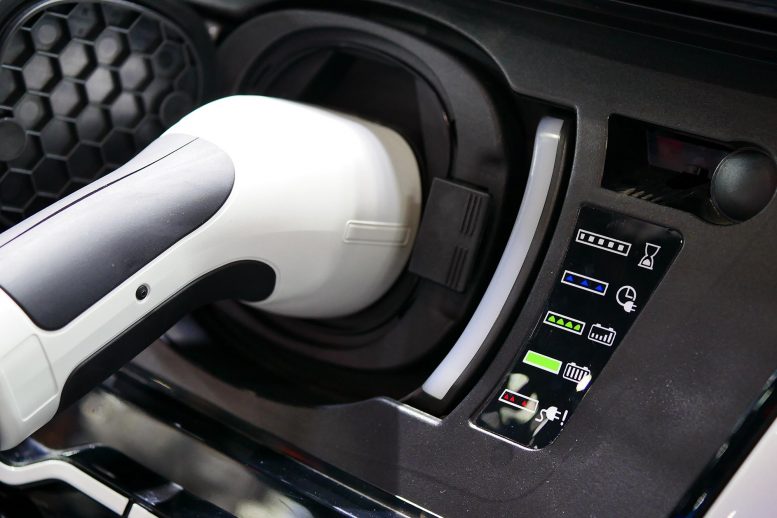
Society needs more and better batteries to power fleets of electric cars.
Thanks to the boom in renewables, these days the limiting factor of the energy revolution is not power supply as much as power storage. Cleaner, greener batteries are needed to charge our cars, e-bikes, and devices for longer.
It is a situation all of us have been in. You’re busy with some task and the rectangular icon in the top right-hand corner of the screen turns red and flashes to indicate you’re almost out of battery. However, the problems with batteries go far beyond this kind of minor inconvenience. Batteries are a critical component of our green energy future, albeit an imperfect one.
In the future, a large portion of our energy is expected to come from renewable sources such as solar and wind. Yet we all know that there are times when the wind does not blow and the sun does not shine. To balance supply, we need to store the surplus electricity generated by renewables, until we are ready to consume it. Better batteries are one important way of doing this. If we are to power the envisioned fleets of electric cars and mobility devices, we will need huge numbers of batteries.
A big ongoing issue is that even the best batteries have problems. For example, one big sticking point with lithium-ion cells is that they use lithium as a key component. This is mined as salt. Since Europe does not presently have any large reserves, it relies on imports from only a small number of places, such as Australia and Chile. Other problems with lithium batteries are that they are expensive, have a limited storage capacity, and lose performance after repeated charging.
If we are to improve them, we need to first understand how they work. Traditional lithium-ion batteries have three key components. There are two solid components called electrodes – the anode and the cathode – and a liquid called the electrolyte. When the battery discharges, electrons stream out of the anode to the cathode to power whatever device it’s connected to. Positive lithium ions diffuse through the electrolyte, attracted to the negative charge of the cathode. When the battery is being charged up, this goes in reverse.
Energy density
The whole process is a reversible electrochemical reaction. There are many flavors of this basic process with different kinds of chemicals and ions involved. A particular option being explored by the ASTRABAT project is to do away with the liquid electrolyte and make it a solid or gel instead. In theory, these solid-state batteries have a higher energy density, meaning they can power devices for longer. They should also be safer and quicker to manufacture, since, unlike typical lithium-ion batteries, they don’t use a flammable liquid electrolyte.
“We need to continue to invest in research to validate the next generation of batteries.”
— Dr. Sophie Mailley, ASTRABAT
Electrochemist Dr. Sophie Mailley at the Atomic Energy and Alternative Energies Commission (CEA) in Grenoble, France, is the ASTRABAT project coordinator. She explains that lithium-based solid-state batteries do already exist. But such batteries use a gel as the electrolyte and only work well at temperatures of about 60 C (140 F), meaning they are unsuitable for many applications. “It’s clear that we need to innovate in this area to be able to face the problems of climate change,” said Dr. Mailley.
She and her team of partners have been working on perfecting a recipe for a better solid-state lithium battery. The job involves looking at all sorts of candidate components for the battery and working out which ones work best together. Dr. Mailley says they have now identified suitable components and are working out ways to scale up the manufacturing of the batteries.
One question she and her team plan to investigate next is, whether it will be easier to recycle lithium and other elements from solid-state batteries compared to typical lithium-ion batteries. If it is, that could increase the recycling of lithium and reduce dependence on imports.
Dr. Mailley estimates that if the research goes well, solid-state lithium batteries like the one ASTRABAT is working on could be entering commercial use in electric cars by about 2030. “I don’t know if it is these solid-state batteries that will be the next important battery innovation,” said Dr Mailley. “There are a lot of other possible solutions, like using manganese or sodium (instead of lithium). Those might work out. But we need to continue to invest in research to validate the next generation of batteries,” she said.
Positively charged
When it comes to storing energy for the purposes of smoothing out supply to electricity grids, batteries need to be reliable and high capacity, which means expensive. Scarce lithium isn’t the best choice. Instead, the HIGREEW project is investigating another different kind of battery, known as a redox flow cell.
The main components of redox flow batteries are two liquids, one positively charged, and one negatively charged. When the battery is in use, these are pumped into a chamber known as a cell stack, where they are separated by a permeable membrane and exchange electrons – creating a current.
The project’s coordinator is chemist Dr. Eduardo Sanchez at CIC energiGUNE, a research center near Bilbao in Spain. He explains that plenty of large-scale redox flow batteries are already in operation around the world and they are designed to be stable, lasting about 20 years. But these existing batteries use vanadium dissolved in sulfuric acid, which is a toxic and corrosive process. Safety requirements mean these batteries must be manufactured at great expense.
“I would say we have a bloom here in Europe, with a lot of companies working on flow batteries.”
— Dr. Eduardo Sanchez, HIGREEW
“Vanadium has lots of strengths – it’s cheap and stable,” said Dr. Sanchez. “But if you have a leak from one of these batteries, that’s not nice. You must design the tanks to be extremely durable.”
Less toxic
The HIGREEW project is planning to create a redox flow battery that uses far less toxic materials such as salt solutions in water which stores carbon-based ions. Sanchez and his team of colleagues have been working on developing the best recipe for this battery, screening many different combinations of salts and chemical solutions. They have now come up with a shortlist of a few prototypes that perform well and are working on scaling these up.
Work on one huge prototype battery is ongoing at the CIC energiGUNE center. “We have to ensure that they maintain their good performance at scale,” said Dr. Sanchez.
His team has also been investigating a method of dipping commercially available battery membrane materials so as to chemically alter them, making them last longer.
Dr. Sanchez sees a bright future for redox flow batteries. “I would say we have a bloom here in Europe, with a lot of companies working on flow batteries.” He predicts that manufacturing redox flow batteries could bring abundant employment opportunities to Europe in the coming years.
Research in this article was funded by the EU.
This article was originally published in Horizon, the EU Research & Innovation Magazine.









All one has to watch is the documentary on how the children in Africa are slaved to work in mines to extract the metal used in electric batteries for as little as 1-2 pence a day. So it is not all good until someone finds a way to improve the life of batteries using the sun as a source of energy.
Yes, it is a significant oversight not to mention that cobalt is critical to present-day battery technology, and it is a rare commodity.
As to the concern about child labor in the Congo, they are not “slaved.” The whole family works together. I suppose the children could stay home and starve.
I can remember as a small child, probably less than 4, being in a corn field with my parents as they shucked corn to earn extra money during WWII. The experience didn’t harm me. I couldn’t reach the ears of corn at that age. However, what if I had found things of value lying on the ground that my parents could have sold? Would it have been wrong for me to pick them up to help feed the family?
“Thanks to the boom in renewables, these days the limiting factor of the energy revolution is not power supply as much as power storage.”
That is a reasonably accurate statement for the situation today. However, if alarmists have their way, we will all be forced to drive electric vehicles. That will be a different world! There won’t be enough power available, and every home in the developed countries will have to have their wiring upgraded to accommodate rapid charging of at least one or two cars. People may have to park their cars in their driveways to avoid prohibitive home fire insurance rates because of the frequent spontaneous combustion of lithium-ion batteries. Nobody has offered a solution for the millions of people who live in apartments or small flats in cities and have to park their cars on the adjoining streets.
The people trying to save the world are driving with dark glasses and blinders.
electricity is everywhere in the developed world. If you have enough voltage for a clothes drier, you have enough to charge a car. Cars do not need rapid charging at home. Every utility pole carrying an electric wire is a potential site for a charging apparatus.
Ignoring the fact that burning stuff to move cars and heat homes is heating our planet to dangerous levels is failing to see the problem.
Not everyone has access to their own utility pole. Many people have to park on the street, and can’t always get the same spot. It isn’t an unsolvable problem, but one that will inconvenience most urban dwellers.
Where I live, many homes have 3 or 4 cars, being driven by working parents and teenage family members. So, the electrical system has to be able to accommodate all the cars, not just one. Also, consider the situation where a family gets in late on a Sunday night, and needs to get up early to go to work. That means a fast charge, or go into work/school very late.
There are no utility poles in my neighborhood. All the power lines are underground. To upgrade my electricity, and my neighbors, means replacing transformers and probably digging up all the lines (expensive, time-consuming, and inconvenient) to put in secondary 240-V charging lines.
It is a commonly held opinion that “burning stuff” is heating our planet. However, I don’t agree that it is a “fact.”
AI, CRISPR, Stem cells, optical and quantum tech and neural implants will revolutionize the next 50 years w longer lives, plenty of healthy eating, shelter and focus on fun
It is refreshing seeing an optimist, considering all the bad news in the world. However, being a Pollyanna, doesn’t necessarily make it happen.
A social corollary of Newton’s Third Law, “For every action there is an equal and opposite reaction.” — is unintended consequences. There is plenty of evidence that technology has lots of downsides, with carcinogens associated with “Better Living Through Chemistry,” leading to shortened lives, rampant obesity and Type 2 diabetes because of the calories consumed and sedentary lives, and people dying from recreational drugs because they have no purpose in life except “fun.”
Yes, we must learn how to better use that big refactor in our solar system aka the Sun! For free for the world. How dare I say FREE!! :”>♡}
As NASA has discovered, there is no such thing as a ‘Free Launch.’ There are always costs! One of the costs of solar is that land that could otherwise be used for agriculture or grazing is often used by solar farms. And, as California is just now discovering, the early-adopters of solar are now having to replace the aged panels, and because they are laden with toxic metals, they are having a difficult time finding suitable disposal sites.
Gosh, there are some desperately ill-informed comments here. Strange because this is a science publication.
A HUGE glaring mistake in this article claims lithium is minutes from Australia and Chile. A minute amount comes from those countries while the bulk comes from destroying the Congo Rainforest in the Democratic Republic of the Congo. There is nothing green about current electric cars. You’re simply exporting pollution to Africa.
This article is rife with errors. From the beginning, the author postulates that energy is tnot the problem – storage is. What hooey! Energy certainly is a HUGE problem. Each electric car purchased by a mixed-energy source family doubles their annual electrical consumption. The average number of cars in car-owning households is two – that means tripling the available grid power in order to charge those cars. With so many areas already experiencing brown and black outs due to limited available electrical current, we will not be able to charge a massive influx of electric cars – not for generations. We will need thousands of new power plants and massive investment in other infrastructure, like towers, wires controls and transformers. It is estimated that most neighborhood transformers could support only 4 total electric cars before required upgrade – multiply THAT across the United States! What we really need is freedom to allow markets to work – to devise new battery techs, to gradually enlarge our power grid, and to build better electric cars.